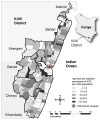Active convulsive epilepsy in a rural district of Kenya: a study of prevalence and possible risk factors
- PMID: 18068520
- PMCID: PMC4058896
- DOI: 10.1016/S1474-4422(07)70292-2
Active convulsive epilepsy in a rural district of Kenya: a study of prevalence and possible risk factors
Abstract
Background: Few large-scale studies of epilepsy have been done in sub-Saharan Africa. We aimed to estimate the prevalence of, treatment gap in, and possible risk factors for active convulsive epilepsy in Kenyan people aged 6 years or older living in a rural area.
Methods: We undertook a three-phase screening survey of 151,408 individuals followed by a nested community case-control study. Treatment gap was defined as the proportion of cases of active convulsive epilepsy without detectable amounts of antiepileptic drugs in blood.
Findings: Overall prevalence of active convulsive epilepsy was 2.9 per 1000 (95% CI 2.6-3.2); after adjustment for non-response and sensitivity, prevalence was 4.5 per 1000 (4.1-4.9). Substantial heterogeneity was noted in prevalence, with evidence of clustering. Treatment gap was 70.3% (65.9-74.5), with weak evidence of a difference by sex and area. Adjusted odds of active convulsive epilepsy for all individuals were increased with a family history of non-febrile convulsions (odds ratio 3.3, 95% CI 2.4-4.7; p<0.0001), family history of febrile convulsions (14.6, 6.3-34.1; p<0.0001), history of both seizure types (7.3, 3.3-16.4; p<0.0001), and previous head injury (4.1, 2.1-8.1; p<0.0001). Findings of multivariable analyses in children showed that adverse perinatal events (5.7, 2.6-12.7; p<0.0001) and the child's mother being a widow (5.1, 2.4-11.0; p<0.0001) raised the odds of active convulsive epilepsy.
Interpretation: Substantial heterogeneity exists in prevalence of active convulsive epilepsy in this rural area in Kenya. Assessment of prevalence, treatment use, and demographic variation in screening response helped to identify groups for targeted interventions. Adverse perinatal events, febrile illness, and head injury are potentially preventable associated factors for epilepsy in this region.
Figures


Comment in
-
Estimations of the prevalence of epilepsy in sub-Saharan Africa.Lancet Neurol. 2008 Jan;7(1):21-2. doi: 10.1016/S1474-4422(07)70295-8. Lancet Neurol. 2008. PMID: 18068521 No abstract available.
References
-
- WHO . The World Health Report: 2001: Mental health: new understanding, new hope. 2001.
-
- Preux PM, Druet-Cabanac M. Epidemiology and aetiology of epilepsy in sub-Saharan Africa. Lancet Neurol. 2005;4(1):21–31. - PubMed
-
- Sander JW. The epidemiology of epilepsy revisited. Curr.Opin.Neurol. 2003;16(2):165–70. - PubMed
-
- Ndoye NF, Sow AD, Diop AG, Sessouma B, Séne-Diouf F, Boissy L, Wone I, Touré K, Ndiaye M, Ndiaye P, de Boer H, Engel J, Mandlhate C, Meinardi H, Prilipko L, Sander JWAS. Prevalence of epilepsy its treatment gap and knowledge, attitude and practice of its population in sub-urban Senegal an ILAE/IBE/WHO study. Seizure. 2005;14:106–111. - PubMed
-
- Central Bureau of Statistics . Vol. 64. Kenya Government; Nairobi: 2000.
Publication types
MeSH terms
Grants and funding
LinkOut - more resources
Full Text Sources
Medical
Miscellaneous

